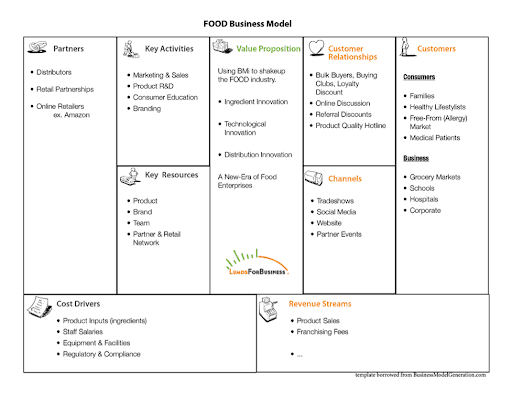Using a Business Model Canvas to plan your restaurant’s business model is an excellent way to develop a clearer understanding of how you will best meet your customers’ needs. This process involves analyzing the elements of your business model, including your customers, revenue streams, customer relationships, and cost structure. This article will give you tips on how to create your business model and if you want to learn more about it, check Digital Leadership.
Understand your market before filling out the value proposition
One of the most important aspects of a restaurant’s business model is its unique value proposition. The value proposition describes the features and benefits that make your restaurant stand out from competitors. The value proposition can be anything from menu selections to the service and atmosphere. Whether you are looking to attract a local neighborhood crowd or an international one, there are ways to make your restaurant stand out from the rest.
Once you have a solid understanding of the market and what your customers want, you can start filling out the value proposition canvas. The key is to look at your business from the customer’s perspective and answer all the questions they may have. You may want to start by identifying the jobs your potential customers have. This can include information about their current situation, past behavior and decisions, and situational analysis.
A value proposition should help you determine the direction your business is taking. It should be clear and unique. Avoid including too many voices in your value proposition canvas, because too many voices can dilute it and make it less compelling. A small group will allow you to hone the options until they become clear and compelling.
In addition to the value proposition, you should also consider the cost structure. The cost structure includes all the money that goes into running your business. This includes the costs of resources, key activities, partnerships, and opportunity costs. For example, a restaurant may need to hire a chef. These costs will include a salary for the chef, electricity bills, local lease, and other expenses.
Value proposition canvas can help you enter a new market or refine your marketing strategy. It will help you understand the needs of your target market and create a product that addresses those needs.
Develop hypotheses for all the costs structure
The Business Model Canvas (BMC) is a framework that focuses on external and internal factors to help business owners create a viable business model. The model emphasizes defining a value proposition and establishing key stakeholders. The value proposition explains what the business will offer to customers and is the primary driver of its operations. For example, a music streaming service like Spotify focuses on providing music to people of all ages. This value proposition is different from the value proposition of its competitors.
The Cost Structure is another important element to understand when developing a business model. In many businesses, the costs are not well understood, and this is the number one reason they fail. To get a better understanding of these costs, entrepreneurs need to develop hypotheses for all the costs related to the business.
They must also consider the costs of acquisition and startup, as well as ongoing operating costs. Once the team has created their hypotheses, they need to gather data to support the assumptions that they have made. This information helps them decide if they should pivot or continue to pursue the business model.
After defining the customer market and the customer base, a business model can develop the appropriate cost structure. This will help the business team determine if they should focus on reducing costs or maximizing value. Cost-driven models focus on cost minimization, while value-driven businesses focus on creating value for customers.
Understand Your Customer relationships
The Customer Relationships Building Block of the Business Model Canvas describes the relationships that your business will have with your customers. These relationships are important because they will affect how you interact with your customers, as well as how you retain them and upsell them. There are three types of customer relationships that you should consider in your business model.
The first type is customer-centric. This means that you are interested in getting feedback from your customers. A business that focuses on this type of relationship will attract new customers. Positive relationships will also encourage your customers to recommend your business to others. As a result, you will establish yourself as a valued partner and keep customers coming back.
The second type of customer-centric business is a service-based business. A service-oriented business uses a service model to provide a good customer experience. This type of business model helps you identify trends among your customers and identify how they purchase your products. Customer relationships are essential to the success of any restaurant. They will help you to streamline your marketing efforts.
Next, customer-centric businesses use upselling as a key strategy to sell more products. Upselling involves incorporating higher-priced products and services into the overall menu. This strategy allows businesses to build trust with their customers while maintaining a balanced budget between acquiring new customers and retaining existing ones.
Segment customers based on similarities
Segmenting your customers based on similarities in your business model canvas will help you better meet the needs of these groups and maximize economic value. Identifying segments based on common interests and behaviors can also help you better understand your target audiences. You can identify which groups are most likely to make repeat purchases, and what features they want.
Creating customer segments is a critical part of creating a successful business plan. Without the proper customer segmentation, a company will not succeed. Without customers, there will be no product or service to sell, and you will not be able to stay in business.
By analyzing the characteristics of each customer segment, you can develop marketing campaigns that are relevant to each segment. This will help you create unique customer experiences and increase return business. Customers no longer want generic marketing messages that are not relevant to their needs. This approach can help you segment customers based on similar interests, behaviors, and demographics, thereby increasing the effectiveness of your marketing campaigns.
Another method of segmenting customers based on similarity is to create a profile for each customer group. Then you can better understand the needs of each customer segment by using different criteria. For example, you can look at the age, gender, and income of each customer group. Then you can compare these with your customers’ psychographics, such as their interests, hobbies, and preferences. These attributes will help you recognize which types of customers are most likely to return to your restaurant.
Another method to segment customers is by using design thinking. In addition to using the Business Model Canvas to determine what the target audience wants, it also helps to understand their pain points. The more intense their pain points, the more likely they will be willing to pay for your products and services.
Improve Your Revenue streams
The final element of the business model canvas is the revenue streams. This is the core of the business and is the primary driver of operations. An example of a value-driven business model is Spotify, which has a mission of “Music for all.” It wants to be a streaming service for everyone, and provide a variety of music selections.
Revenue streams are the methods a business uses to collect cash from customers. Depending on the type of business, these streams can be different from one another. They represent different types of value propositions and how customers will pay for them. Revenue streams are also important because they help determine how a business can make money and how it should be priced.
One popular revenue stream in a restaurant is food delivery. A full-service restaurant may combine multiple revenue streams, including food delivery. This adaptive business model aims to draw customers into the physical space without depending on deliveries, which can eat into profit margins. Ultimately, revenue streams are critical to the survival and growth of any restaurant business.
Another way to create a successful revenue stream is by adding value to your products. Wine is a great example. Vintage, a Spanish winemaker, innovated in a competitive market. The wine industry is steeped in tradition and history, and it can be very difficult for newcomers to grab market share. But Vintae’s innovation helped it stand out from its competition.
Other ways to generate revenue from customers include offering a subscription model. Some restaurants provide a subscription service where subscribers receive one or more menu items each day. These subscriptions are very popular and can generate revenues for a restaurant regularly. Restaurant subscriptions can cost upwards of $1,000 a year. Many industry experts believe this type of subscription model has great potential. The average subscription plan can bring in over $300 in revenue per meal.
Meal kits can also be a great revenue stream. They can include packaged ingredients, recipes, and easy-to-follow instructions. These meal kits are similar to take-and-bake kits. Meal kits can be picked up at a restaurant or delivered. A restaurant that offers these meal kits is uniquely positioned to grow this new category.


































